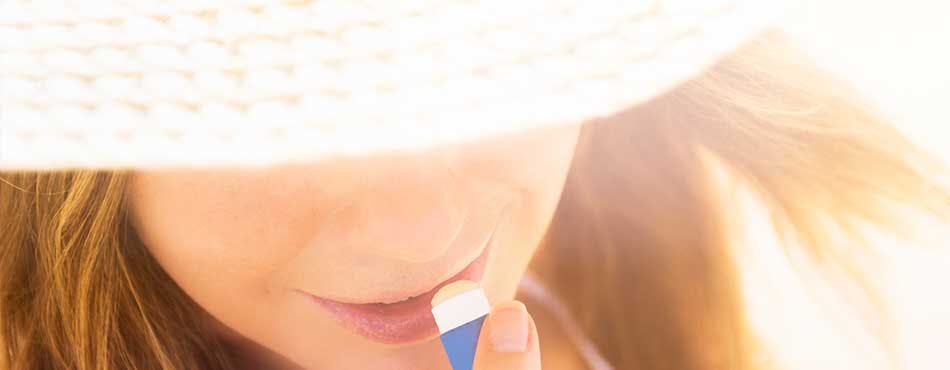Back to Managing Your Triggers articles

The Sun and Cold Sores
Sunlight is a proven trigger of cold sores. 1 But that doesn’t mean you have to spend your summer hiding inside. Using sunscreen and a lip balm that provide broad-spectrum sun protection with a minimum SPF of 30 can help protect you from cold sores. 2 Learn more about sun and cold sores below.
Find Your Spot in the Shade
Whether you’re running at the beach, hiking in the mountains or simply walking to the corner store, sun is an element we’re exposed to on a regular basis. Regardless of whether you live in a sunny location like L.A., or a cloudy location like Seattle, it’s important to protect your skin. Sun damage is possible on windy, cloudy and cool days.3 You may not be able to see the sun, but it’s still there.
Many of us love the sun, but it also has its risks when it comes to skin and lip health—including triggering cold sores. Read on to find out how to prevent and treat cold sores from the sun.
What Is a Cold Sore?
First things first, what exactly is a cold sore? Cold sores are small blisters around the mouth area.4 Cold sores are caused by the herpes simplex virus (usually herpes simplex virus 1).5 The herpes simplex virus can lie dormant for years, so even if your cold sore outbreak clears up, you can still experience another outbreak in the future.6
Some people who have the herpes simplex virus don’t show any symptoms.7 If you do have any symptoms, they might include the following:8
- Tingling of the lips (usually felt before cold sores appear)
- Small blisters around the mouth area that may enlarge or burst
- Itching, dryness, soreness and irritation around the lips and mouth
Cold sore symptoms can vary from person to person. If you believe you’re experiencing an outbreak, consult your doctor for a diagnosis.
Can the Sun Cause Cold Sores?
Our answer: yes and no. Remember, the leading cause of cold sore outbreaks is herpes simplex virus 1. This virus is fairly common. In fact, according to the World Health Organization, more than two-thirds of the population under 50 have the herpes simplex virus.9 The sun cannot cause a cold sore on its own. However, if you do carry the virus, the sun can trigger a cold sore outbreak.10
Why Does the Sun Cause Cold Sores?
Sun and cold sores: what’s the link? Many people are familiar with the risks of UV exposure, such as sunburn. These UV rays responsible for sunburn are the same ones responsible for cold sores. UVR plays a role in recurrent cold sore outbreaks.11 Luckily, you don’t need to swear off fun in the sun for good. Just be sure to protect your lips to mitigate your risk of an outbreak.
How to Protect Your Lips from the Sun
SPF is your best ally when it comes to protecting your lips from the sun. Wear a lip balm with a SPF of 30 or higher to help prevent cold sores from the sun. Keep in mind that sunscreen’s effectiveness can be affected by wind, water, humidity, and altitude. Plus, you can sweat or lick your lip balm off without realizing it, so reapply it often.
Remember, cloudy days are not your ally in the battle against cold sores, because those are the times when you may forget to wear your lip balm and sunscreen. UV rays can penetrate clouds and even thick fog. In order to keep your skin and lips healthy, practice sun-safe habits each day, regardless of how many clouds there are.
Cold Sore Treatment
If you do experience a cold sore outbreak from the sun, consider Abreva. Abreva® can heal a cold sore in as few as 2½ days when used at the first sign.* Nothing heals a cold sore faster.**
Summer brings along vacations, as well as parties and late nights, which are great until you feel that dreaded cold sore tingle. Fight back by limiting your late nights to when you know you can sleep late the next morning—and carry a tube of Abreva Cream in your cosmetic bag, just in case.
*Median healing time 4.1 days. 25 percent of users healed within 2½ days.
**Among OTC cold sore treatments, Abreva contains the only OTC ingredient approved by the FDA to shorten healing time and duration of symptoms.
SOURCES
1. Sunlight is an important causative factor of recurrent herpes simplex. PubMed. https://www.ncbi.nlm.nih.gov/pubmed/15603217. Accessed 1/8/2021. Referenced text is highlighted in source PDF.
2. Cold sores: Diagnosis and Treatment. https://www.aad.org/public/diseases/a-z/cold-sores-treatment. Accessed 1/8/2021. Referenced text is highlighted in source PDF.
3. 10 Myths About Sun Protection. Cancer Council. https://www.cancer.org.au/assets/pdf/10-myths-about-sun-protection. Accessed 1/7/2021. Referenced text is highlighted in source PDF.
4. Cold Sores. John Hopkins Medicine. https://www.hopkinsmedicine.org/health/conditions-and-diseases/cold-sores. Accessed 1/8/2021. Referenced text is highlighted in source PDF.
5. Cold Sores. John Hopkins Medicine. https://www.hopkinsmedicine.org/health/conditions-and-diseases/cold-sores. Accessed 1/8/2021. Referenced text is highlighted in source PDF.
6. Cold Sores. John Hopkins Medicine. https://www.hopkinsmedicine.org/health/conditions-and-diseases/cold-sores. Accessed 1/8/2021. Referenced text is highlighted in source PDF.
7. Cold Sores. John Hopkins Medicine. https://www.hopkinsmedicine.org/health/conditions-and-diseases/cold-sores. Accessed 1/8/2021. Referenced text is highlighted in source PDF.
8. Cold Sores. John Hopkins Medicine. https://www.hopkinsmedicine.org/health/conditions-and-diseases/cold-sores. Accessed 1/8/2021. Referenced text is highlighted in source PDF.
9. Globally, an estimated two-thirds of the population under 50 are infected with herpes simplex virus type 1. World Health Organization. https://www.who.int/news/item/28-10-2015-globally-an-estimated-two-thirds-of-the-population-under-50-are-infected-with-herpes-simplex-virus-type-1. Accessed 1/8/2021. Referenced text is highlighted in source PDF.
10. Cold Sores. John Hopkins Medicine. https://www.hopkinsmedicine.org/health/conditions-and-diseases/cold-sores. Accessed 1/8/2021. Referenced text is highlighted in source PDF.
11. Sunlight is an important causative factor of recurrent herpes simplex. PubMed. https://www.ncbi.nlm.nih.gov/pubmed/15603217. Accessed 1/8/2021. Referenced text is highlighted in source PDF.







